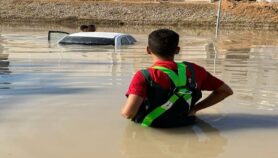By: Prime Sarmiento
Send to a friend
The details you provide on this page will not be used to send unsolicited email, and will not be sold to a 3rd party. See privacy policy.
[MANILA] Coastal vegetation offered little protection against the 2004 tsunami in Aceh, Indonesia, according to a "seminal" contribution to the debate about mangroves and tidal waves.
There has been much debate about whether coastal forests can cut the impact of tsunamis. For example, following the tsunami that struck the Indian Ocean in December 2004, early assessments indicated that areas with dense mangroves had suffered fewer casualties and less property damage.
However, scientists have criticised planting mangroves as ‘bioshields’, saying they destroy natural ecosystems and there is little evidence that they protect against tsunamis.
In the new study, published in Proceedings of the National Academy of Sciences last month (15 November), researchers from Germany and Indonesia collected data from the coastlines of Aceh, the Indonesian province severely affected by the 2004 tsunami. The area has dense tree cover, including mangroves, which was expected to serve as a bioshield.
The researchers found that coastal vegetation reduced the number of human casualties by three to eight per cent. But vegetation situated behind villages had the opposite effect — increasing the number of casualties by up to six per cent, possibly because people were swept against the trees by waves.
Furthermore, even coastal vegetation could do nothing to protect people against extreme wave height, they say.
"For sustainable and effective coastal risk management, location of settlements is essential, while coastal vegetation should be regarded as an important livelihood provider rather than just as a bioshield," the researchers noted.
Sonya Dewi, head of the spatial analysis unit at the World Agroforestry Centre’s South-East Asia regional office, and one of the study authors, told SciDev.Net that they focused on "understanding the tree cover’s mixed role in managing risks" and not just the effectiveness of mangroves in helping communities survive a tsunami.
To protect against a tsunami, she suggested that "settlements should be sufficiently far from the coastline while maintaining coastal vegetation" and escape routes to the closest, highest point should be maintained.
"We hypothesise that with less extreme wave height the positive effect of coastal vegetation will be more significant, but similar studies should be conducted to test this," Dewi said.
In an accompanying commentary, Roland Cochard of the Institute of Integrative Biology at the Swiss Federal Institute of Technology, hailed the study as "seminal" and said it had "a remarkable set of data".
"To date, few studies focusing on bioshields have convincingly taken account of wave variability caused by [tsunamis]; conclusions regarding the role of vegetation have, therefore, tended to reflect personal bias … In contrast, [this] work … controls the overriding off-shore effects by selecting a fairly uniform, flat sedimented (without coral reefs) coastline."
But Jurgenne Primavera, manager of the Community-Based Mangrove Rehabilitation Project in the Philippines — which is building a greenbelt along the Philippine coastlines — said that mangroves "are the first defence against rising waves so that you can do an upland retreat".
Link to full paper in Proceedings of the National Academy of Sciences













